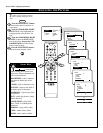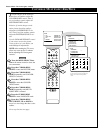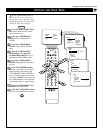
4
TABLE OF CONTENTS
GETTING STARTED
PICTURE MENU
FEATURES MENU
SOUND MENU
Adjusting the Picture . . . . . . . . . . . . . . . . . . . . . .6
Turning on the Dynamic Noise
Reduction (DNR) Control . . . . . . . . . . . . . . . . . .7
Turning on the ImageMax Control . . . . . . . . . . . .8
The Convergence Control:
•Converge Red/Blue . . . . . . . . . . . . . . . . . . . .9
•Converge Multipoint Red/Blue . . . . . . . .10–11
•Undo Multipoint . . . . . . . . . . . . . . . . . . . . .12
Welcome/Product Registration . . . . . . . . . . . . . . . .2
Safety Precautions . . . . . . . . . . . . . . . . . . . . . . . . .3
Table of Contents . . . . . . . . . . . . . . . . . . . . . . . . .4
Features . . . . . . . . . . . . . . . . . . . . . . . . . . . . . . . . .5
The Timer Control:
•Setting the Clock . . . . . . . . . . . . . . . . . . . . .13
•Setting the Start Time . . . . . . . . . . . . . . . . .14
•Setting the Stop Time . . . . . . . . . . . . . . . . .15
•Selecting the Channel . . . . . . . . . . . . . . . . .16
•Selecting the Tuner . . . . . . . . . . . . . . . . . . .17
•Setting the Activate Control . . . . . . . . . . . .18
•Constantly Displaying
the Time on Screen . . . . . . . . . . . . . . . . . .19
The AutoLock Control:
•Understanding AutoLock . . . . . . . . . . . . . . .20
•Setting up the Access Code . . . . . . . . . . . . .21
•Blocking Channels . . . . . . . . . . . . . . . . . . .22
•Blocking by Movie Rating . . . . . . . . . . . . .23
•Blocking by TV Rating . . . . . . . . . . . . . . . .24
•Turning the Blocking Control
on or off . . . . . . . . . . . . . . . . . . . . . . . . . .25
•Blocking Unrated Broadcasts . . . . . . . . . . .26
•Blocking Broadcasts
That Have No Rating . . . . . . . . . . . . . . . .27
•Reviewing Your Settings . . . . . . . . . . . . . . .28
•Clearing All Blocked Channels . . . . . . . . . .29
Using the Closed Captioning Control . . . . . . . . .30
Adjusting the Treble, Bass,
and Balance . . . . . . . . . . . . . . . . . . . . . . . . . . .31
Using the AVL (Audio Volume Leveler)
Control . . . . . . . . . . . . . . . . . . . . . . . . . . . . . . .32
Using Incredible Surround . . . . . . . . . . . . . . . . .33
Setting the TV for Stereo and SAP . . . . . . . . . . .34
Setting the Audio Out Control . . . . . . . . . . . . . . .35
Using the TV Speaker Control
and Audio Outputs . . . . . . . . . . . . . . . . . . . . . .36
Using the Bass Boost Control . . . . . . . . . . . . . . .37
REMOTE CONTROL
AutoLock, AutoPicture, AutoSound, ImageMax, and Incredible Surround are trademarks
of Philips Consumer Electronics Company. Copyright © 2001 Philips Consumer
Electronics Company. All rights reserved.
Using AutoPicture . . . . . . . . . . . . . . . . . . . . . . . .38
Using AutoSound . . . . . . . . . . . . . . . . . . . . . . . .39
Using Surf, Alternate Channel,
and Program List . . . . . . . . . . . . . . . . . . . . . . .40
Using the Sleep Timer Control . . . . . . . . . . . . . .41
Using the Volume Buttons . . . . . . . . . . . . . . . . . .42
Using the AV Button . . . . . . . . . . . . . . . . . . . . . .43
Setting the TV Remote to Work
Accessory Devices . . . . . . . . . . . . . . . . . . .44–48
NOTE: This owner's manual is used with several different tele-
vision models. Not all features (and illustrations) discussed here-
in will necessarily match your television set. This is normal and
does not require that you contact your dealer or request service.
Because of continuous product improvements, the information
mentioned in the documents accompanying your product are
subject to change without notice.
THE PICTURE-IN-PICTURE (PIP) FEATURE
Using PIP (Basic Connections) . . . . . . . . . . . . . .49
Selecting the PIP Signal Source . . . . . . . . . . . . . .50
Using the PIP Remote Control Buttons . . . . . . . .51
Adjusting the PIP Color and Tint Controls . . . . .52
GENERAL INFORMATION
Using Connection Options . . . . . . . . . . . . . . .53–54
Helpful Hints . . . . . . . . . . . . . . . . . . . . . . . . . . .55
Glossary of Television Terms . . . . . . . . . . . . . . .56
Index . . . . . . . . . . . . . . . . . . . . . . . . . . . . . . . . . .57
Limited Warranty . . . . . . . . . . . . . . . . . . . . . . . . 58
ON-SCREEN FEATURES
Refer to the simple Setup and Quick Use Guide
(supplied with your TV) for details on the
following:
• Basic TV Connections
• Television and Remote Operation
• On-screen Menu Controls
• How to Use the Installation Features
• Connection Options for Accessory Devices
SETUP AND QUICK USE GUIDE
Ω
Ω
1
2
3
Ω
Ω
RFCoaxial
Cable
75Ω(Ohm)
Cable TV
Company
Cable TVSignal
300Ω(Ohm) to
75Ω(Ohm)
Adapter
Twin–lead Wire
Back of TV
RFCoaxial Cable
75Ω(Ohm)
Outdooror Indoor Antenna
(Combination VHF/UHF)
Receives normal broadcast channels
2–13 (VHF) and 14–69 (UHF).
OR
OR
(The Two-way Signal Splitter
has a single 75-ohm input and
branches to twin 75-ohm outputs.
RF coaxial connecting cables will
be needed for use with the Two-
way Signal Splitter.)
ANT(enna)
“A” Input
PIPANT(enna)
“B” Input
RF
Coaxial
Cables
1
TABLE OF CONTENTS
Getting Started
Warning/Important Notice . . . . . . . . . .1
Basic TVConnections . . . . . . . . . . .1–2
Television and Remote Control Operation . . .2–3
On-screen Menu Controls . . . . . . . . . . . . . . . . .4
How to Use the Installation Features . . . . . . .5–7
Connection Options for Accessory Devices . .7–8
Projection
Television
Projection
Television
Setup and Quick Use Guide
1
2
1
2
3
4
5
6
7
8
9
1
0
1
1
BASIC TV CONNECTIONS
Setup and Quick Use Guide
NOTE: This owner's manual is used with several differ-
ent television models. Not all features (and drawings) dis-
cussed in this manual will necessarily match those found
with your television set. This is normal and does not
require that you contact yourdealer or request service.
WARNING: TO PREVENTFIRE OR SHOCK HAZ-
ARD DO NOT EXPOSE THIS UNITTO RAIN OR
EXCESSIVE MOISTURE.
ANTENNA OR
CABLE TV
Connect two lengths of
RFcoaxial cable to the two
output plugs on the two-way
signal splitter. The two lengths
of RF coaxial cable must have
F-type connectors (screw-on or
push type) on their ends.
Connect one of the RF
coaxial cables coming from
two-way signal splitter to the
PIPANT(enna) “B” input on
the back of the TVand the
other RF coaxial cable to the
ANT(enna) “A” input on the
back of the TV.
Y
our TV has two separate
ANT(enna)/cable inputs
on the back of the set. These
two signal inputs offer conven-
ient hookup options for both
normal TV program viewing
and Picture-In-Picture (PIP)
features.
The ANT(enna) “A” input is
intended for use and viewing
on the TV’s main screen. Your
home’s primary antenna or
cable TV signal should be con-
nected to this input for normal
TV setup, use, and feature
operation.
The PIPANT(enna) “B”
input is a second, or auxiliary,
signal source included for your
TV’s Picture-In-Picture (PIP)
feature. For many homes, the
use of a single existing anten-
na or cable TV source for both
ANT(enna)“A” and PIP
ANT(enna) “B” will be the
preferred method of connection
(see illustration to the right).
This type of connection
(optional signal splitter
required) will work properly
for the TV’s main on-screen
features, as well as retain all
the features designed for PIP.
For more details on PIP, refer
to pages 49–52 in the
Directions for Use manual that
came with your set.
ANTENNAA AND B INPUTS
NOTE: Properoperation of your TV is not dependent upon the connection of the PIP ANT(enna) “B” input. The main purpose of the
input is to provide an easily connected, dedicated picture source for the PIPfeature. You can, however, use the PIPANT(enna) “B” input to
connect and display other signal sources such as an outdoor or indoor antenna or a video game player.
Although the PIPANT(enna) “B” input can be used and swapped as the source for the TV’s main picture, certain setup features (such
as AutoChron) are based only on your TV’s detecting a signal at the ANT(enna) “A” input. To ensure that all features are operating proper-
ly, you may not want to rely solely on the PIPANT(enna) “B” input as your TV’s main screen signal source.
IMPORTANT
AutoChron, AutoPicture, AutoSound, and Incredible Surround are trademarks of Philips Consumer Electronics Company. Copyright ©2001 Philips
Consumer Electronics Company. All rights reserved.
Connect a cable TV
signal to a 75-ohm two-way
signal splitter (an optional
accessory).
Or
Connect an outdoor or
indoor antenna signal to the
75-ohm two-way signal split-
ter. If your antenna has flat
twin-lead wire (300 ohm), you
must first attach the antenna
wires to the screws on a 300-
to 75-ohm adapter before con-
necting to the two-way signal
splitter.
3135 035 20251
See the next page for details
on connecting a cable con-
verter box.
SMART
HELP
Contact your dealer,
or our Parts Information
Center at 1-800-851-8885 to
order the following acces-
sories: two-way signal split-
ter, RF coaxial cable, 300-
ohm to 75-ohm adapter,
combination VHF/UHF
antenna.
You can treat the
output connection of a satel-
lite receiver as you would a
standard antenna or cable TV
signal, except the satellite
signal should not be split as
shown in the illustration to
the right. The satellite signal
should go directly into the
ANT(enna) “A” input con-
nection on the back of the
TV. Then, if you would like,
use the PIPANT(enna) “B”
input connection for either
an outdoor/indoor antenna or
cable TVsignal. Refer to the
owner’s manual for the satel-
lite box to get further infor-
mation on connections.
Run Auto Program to store
in the TV’s memory only the
channels with active broad-
cast stations. See page 5 for
details.
SMART
HELP


















